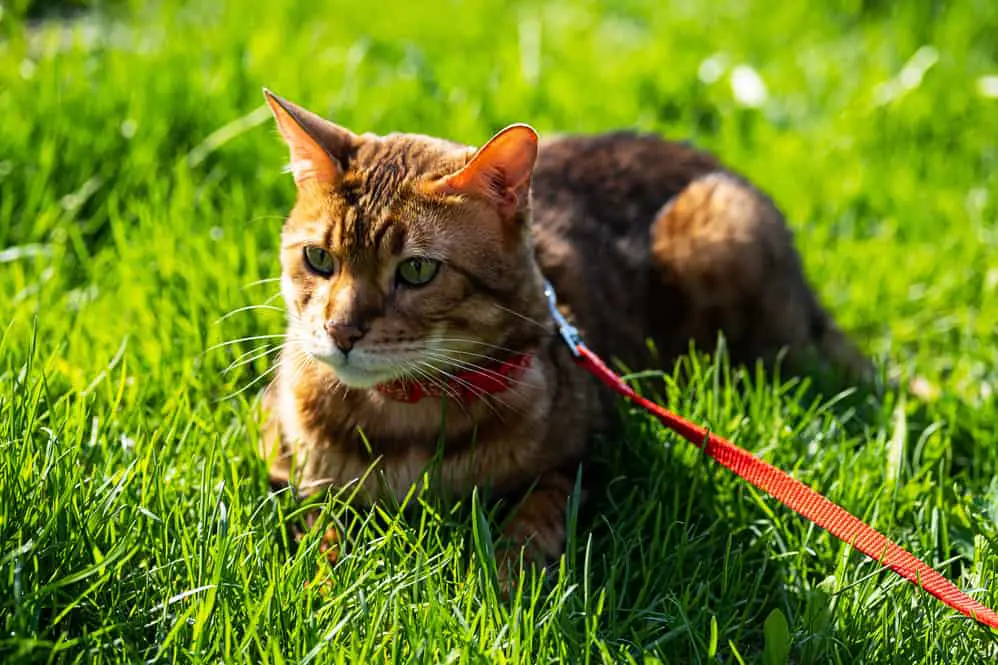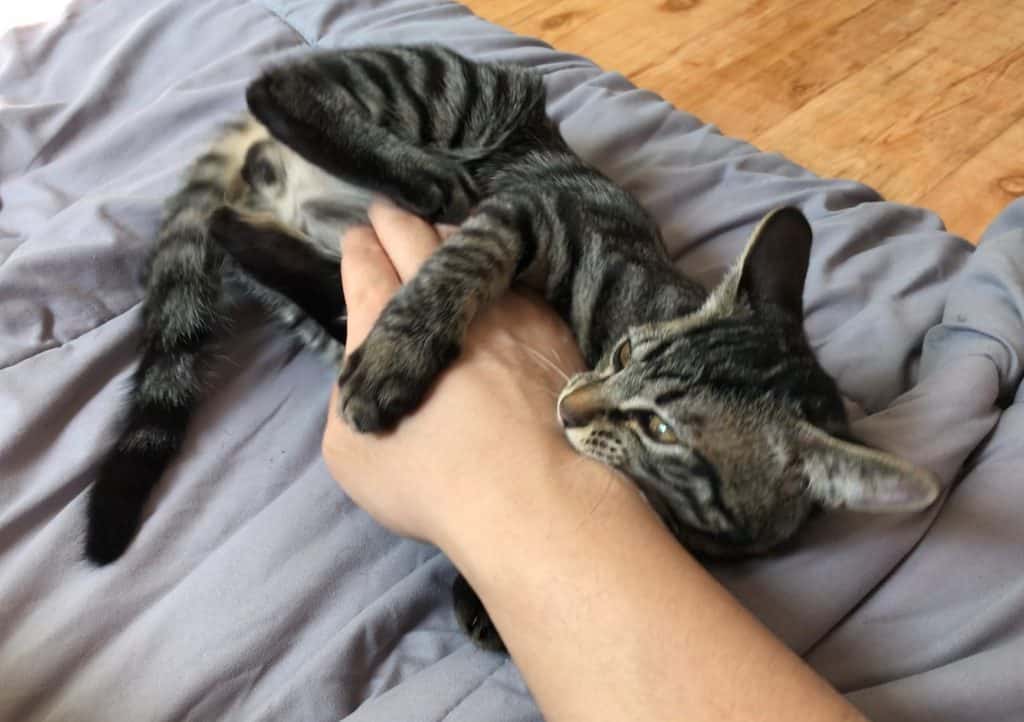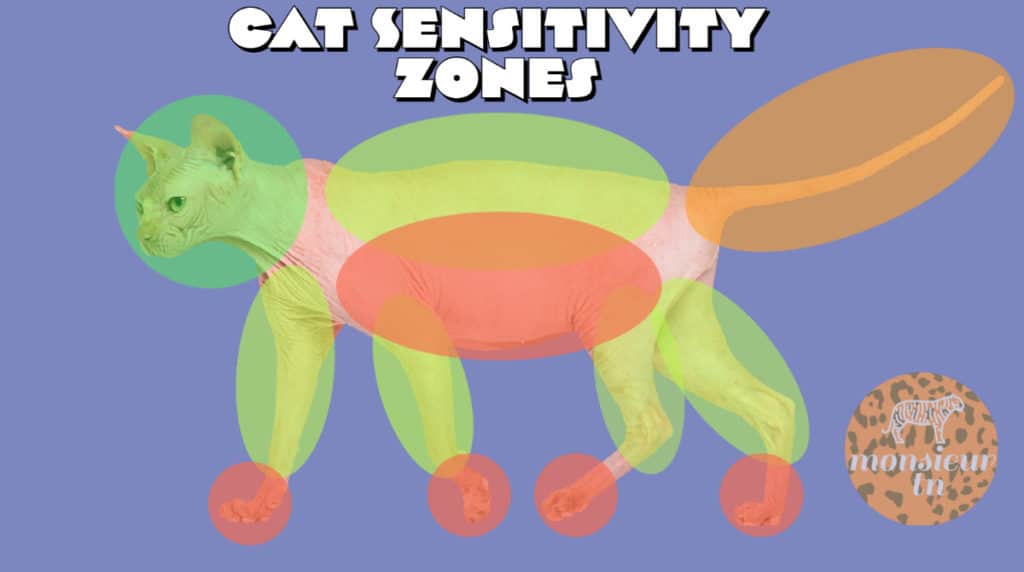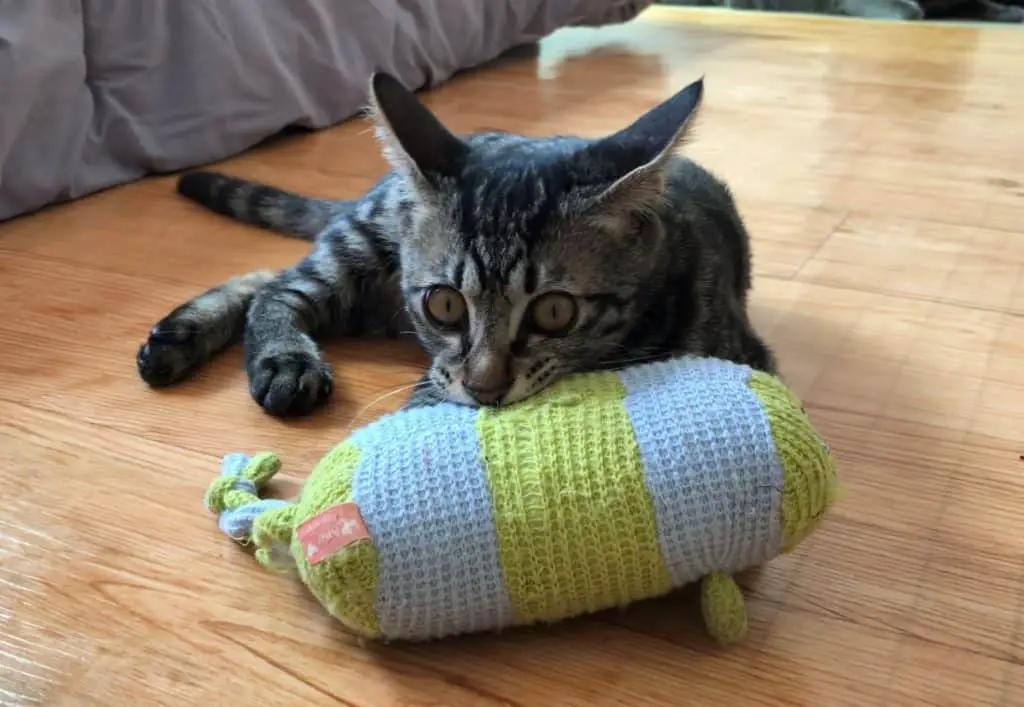Cats bite. It’s part of their nature. However, I’ve been around cats long enough to know that most cats bite humans not because they want to but because they learned to. This guide is to share my experience of how I trained all 4 of my cats, including my Bengal cat, to stop biting from beginning to end.

How Do You Stop Bengal Cats From Biting?
Here are some quick steps to immediately stop a Bengal cat from biting:
- Hiss at them to let them know it’s unacceptable. Kittens and other cats hiss when the play or interaction is too rough.
- Make a loud noise. This can be either a clap, or using an object.
- Keep toys that they can bite in your pocket. This allows them the Bengal cat to replace their habit of biting you with the habit of biting a toy.
- Make it uncomfortable to bite you. Using non-toxic sprays (some people even use hot-sauce, which is also non-toxic to cats) on the places where your Bengal cat bites the most can dissuade them from biting.
- Know their body language to prevent bites and attacks. Knowing a cat’s body language is an important skill that all cat owners should know.
- Tire them out with play or use cat wheels! A tired Bengal cat is a calm Bengal cat!
- Combine all of the above and stay consistent for the best results. Bengal cats are known to be a consistent breed. Their biting behaviors subsides when they approach 8 to 12 month mark.
The sections below will allow cat owners to notice and train their Bengal cats to develop into well-rounded cats that don’t bite!

What to Avoid When Trying to Stop Bengal Cats From Biting
Cats are very different from dogs – they don’t understand and can’t connect the punishment to their behavior. Therefore, they require a different training and disciplining method that’s a lot less direct. Any prolonged direct disciplining of your cats will cause them to fear you, which no cat owner wants.
Avoid doing these things to preserve your relationship with your Bengal cat:
- Angrily shouting at your Bengal cat.
- Physical hitting or pushing.
- Using a spray bottle.
Most Common Reason For a Bengal Cat Biting: Over Stimulation & Boredom
Overstimulation can seem to be a very sudden thing. Sometimes, your Bengal cat could seem super calm and loving one minute, and then all of a sudden, a couple of bites and kicks later, you throw him off your lap in a scream of pain. As kittens, when cats are getting used to new sensations, smells, and the world around them, they can overreact to certain feelings.
My Bengal, Latte, had a pretty bad case of this. A couple of pets and strokes would send him into a fit of excitement, and he will start wrestling with whatever he currently had a grip of with a flurry of kicks and bites. Even my current kitten now is exhibiting these same behaviors. If I was a first-time owner without any experience, it could be alarming and even a little shocking as it does seem to come from nowhere.

Unfortunately, these misunderstandings about biting and aggression do cause issues for their owners. There are cases of some Bengals or cats being given away or abandoned because they thought their cat was too violent or aggressive, which is usually not the case. So I hope this article will clear up some of the misunderstandings that might happen.
Also, it’s important to note that Bengal cats are very energetic cats. If they’re bored, this can lead to a lot more behavioral issues. Therefore, it’s important to give them a lot of attention and playtime either with interactive toys or with a companion cat!
Observation Strategy: Know Your Bengal Cat’s Body Language
Our first step is to step back and really see when they actually bite and why they do it. From my experience, in most biting cases, it’s just a matter of over-stimulation and not aggression or fear. The cat or kitten really does get too excited and can make them start to behave more roughly—especially Bengal cats, as they are just so much more energetic.
This overstimulation is caused by the feeling of static caused by your hands stroking their fur. Some cats will understand this feeling as normal, and others may not! And as a result, they can react to your petting or even sitting on certain types of material as uncomfortable!
This can make cats lash out and try to let you know what it wants you to stop whatever it is you’re doing (which sometimes could be nothing).
Here’s what to look out for in terms of a cat’s body language to know when to interact or not interact with your cat:
| Overstimulated Body Language | Relaxed Body Language | Boredom Body Language |
|---|---|---|
| Quick tail movements. | Still tails or very slowly moving their tails. | Wandering around. |
| Staring at the focus of stimulation. | Unfocused and relaxed. | General destruction. Knocking stuff over & biting random objects. |
| Visibly jittery & finds it hard to stay in one spot. | Sleepy, calm, and still. | Very vocal with drawn-out meows. |
Correcting Overstimulation in Bengal or Active Cats
Once you see the tails start whipping back and forth, be prepared to stop what you’re doing. So what do you do if your feline companion is exhibiting these behaviors? Leave. Any continued interaction with the cat is just reinforcing these behaviors.
So the best course of action to start to correct this behavior is just literally to walk away.
If it has already started biting you, do not react even if it is painful. Try to calmly and slowly move your hand (or whatever it is biting) away and walk away. It lets the cat know that everything stops (including play) if the cat gets too rough!
Once you know when to stop interacting with your Bengal cat, then it’s time to train them to stop biting. Unfortunately, cats that grow up without being taught this at a young age or grew up without a mother (which teaches them to bite inhibition and many other crucial behavior corrections) can be more difficult to train, so it requires a bit of patience and consistency.
Correcting Boredom in Bengal or Active Cats
Boredom tends to be a more straightforward fix since it has to do with their stimulation. Increasing a cat’s engagement can be done in three ways:
- Increase playtime or frequency of playtime with your cats.
- Improve the environment in a way that’s a lot more engaging for cats to interact with.
- Having a companion cat or another animal that they can play with!

A typical adult cat requires about 30 minutes of interactive play a day. A kitten will require more than that! Especially a Bengal kitten. However, if the environment is adequate, kittens can focus their energy on exploring what’s around them!
When Is It Aggression or Fear?
- If a cat is feeling fear, its ears would be the sign it is flattened on its head with dilated pupils.
- If a cat is actually aggressive, most cats would be vocal and start to warn you by growling, hissing, or meowing.

However, there are times when it is legitimately aggression or fear. This would be a bit more obvious as the cat won’t even respond to play or food because it doesn’t feel secure in its environment. In these cases, I would do a more careful investigation and make a thorough inspection of its whereabouts for the whole day.
It could mean several things. Such as sightings/smell of a foreign cat within its territory, health issues, or trauma.
Desensitization Strategy: Train & Stop Bengal Cats to Stop Biting
When is a time your cat is most calm or distracted? These are the times you can start to train them to be more tolerant of your touch and associate them with positive feelings!
There are two times I have observed when they are at their peak tolerance:
- When cats are sleepy or resting after play .
- During their mealtimes.
Eating is the easiest because owners control the time that they can train their Bengal cats. If you’ve been feeding your cats at certain times every day, then it’s easy to have a consistent training schedule.

Begin stroking your cats during meal times and see how they react. Usually, they’ll continue eating and ignore your hand. Try touching their bellies and top of the head. Usually, those are more sensitive areas.
The more you do this while they’re eating, the more they’ll associate your petting with a positive thing (because cats are very highly food motivated). Eventually, they’ll realize that your hand is a source of good feelings and pleasure.
Another thing you could do is to hand feed them. Hand-feeding is one of the most effective ways to associate good feelings towards the hand. While you give them food, maybe give them a little pet. You’ll find that they start to ignore the hand completely and just let you do whatever you want as they munch on their yummies.

Trying to pet them when they’re sleepy is a bit more difficult because it’ll be at random times, but when you observe that your feline friends are a little more lethargic, begin with a gentle touch and move on to a more normal petting.
Watch the tail. The tail will reveal most of what he’s feeling. The more it thrashes, that’s your sign to be a little more gentle and slow. Try a different area. As it slows down or stays still, you know you can maybe go a bit further with your touch to other more sensitive areas maybe or maybe do a full stroke.
It’s a lot of trial and error to see what your cat likes. If the tail continues to thrash and he gets overstimulated. Then stop, walk away and try the above strategy again at another sleepy time. For more methods on how to pet your Bengal cat, read my article (My Cat Won’t Let Me Pet Them!).
Misdirection Strategy: Replace Habits to Stop Bengal Cats From Biting
A lot of cat behaviors are habit-based. Whatever they were used to doing or playing with when they were young, they tend to keep those preferences as they grow up.
So if their owners used a lot of hand-playing during the Bengal cat’s kitten phase, they’d tend to prefer hands to munch on when they get older. This is a problem because the bites are no longer ‘love’ bites, and now they could actually hurt and draw blood. So it’s important to start young.
It might not be hands and feet for your cat. It might be something inanimate. If they begin to bite anything undesirable, such as cables, plastic, then you know they need more physical playtime. More toys will help. Cats, of course, have different personalities, so they’ll prefer different things.

Have different types of toys with different textures and sounds around in the house. Observe and note what toy or item they go crazy for and will play with for hours. Then you put away the ones that they don’t care too much about and take one or two of those toys and keep them in your pocket.
For your convenience, I have curated and put together a list of the best toys for indoor cats with explanations of how to use each one effectively.
Whenever your cat exhibits behaviors that you don’t like, throw them one of those toys. Again, it reinforces the idea that whatever they were biting on before is not as fun as the toy you just threw. And so, it begins to create those habits. It lets them know that some things are meant to be played with, and others are not.
How to Stop Bengal Cats From Biting: Conclusion & Recommendations
None of my adult cats bite anymore. Especially not my Bengal. I can rub him on his belly (which most cats do not like) he wouldn’t react. Even if I try to over-stimulate him he’ll at most give me a fake-out bite. This means he’ll make it seem like he’s going in for a bite but doesn’t do it.
My current kitten is feral and is somehow more energetic than my Bengal when he was a kitten. So I have to be consistent in his socialization as well. I am going through the steps above for the new addition, and he is already learning quickly.
I hope these tips help you in controlling your cat’s biting behaviors. It’s fundamental and simple tips but effectively controls your cat’s behaviors if you’re consistent with it!
Here are some of the most useful misdirection items to replace their bad biting habits into good biting habits:
 Frisco Plush Kicker Cat Toy
Frisco Plush Kicker Cat Toy
This is another great tool for misdirection for when your cat is overstimulated and prone to biting. The furry tail adds motion to stimulate your kitty’s hunting instincts, so toss it to give him the thrill of the chase. It’s also spiked with Canadian catnip for even more exciting play
 Matatabi Sticks Cat Biting Toys
Matatabi Sticks Cat Biting Toys
These sticks have a similar effect to catnip for cats. Have these sticks around for your cats to bite and chew so that they don't chew other stuff around in your apartment or home (cables, electronic components, etc.). It also acts as a great teeth cleaner too!

Hello,
The above information is somewhat helpful. I have already implemented some of the concepts, but the bengal that we adopted, was a stray, we don’t know for how love, but she really wanted to have a family and be an indoor cat. So we took her on and she’ taking us on! Funny but not funny. My belief is that she was someones pet and they let her go due to her aggression, probably brought on by the “hand-play” mentioned above. She is about 16 months old and I have tried so many games in my book to stop her from attacking me and biting me. Toys galore, scratch pads that really do work and talking to her softly. Sometimes she as sweet as ever and then without any warning, she will jump up and either attack my arm or let and bit and wrap her claws around them.
I began petting her during feeding time as soon as we adopted her. She growled at first, but after a few days, realized that I wasn’t going to take her food from her. I can pet her while she eats. I can pet her for only about 1 minute or so before she becomes overstimulated and wants to bite me hand/arm.
We are committed to her as she is now a part of the family and will always be. But I really want to break her of her biting and attacking habits.
I play with her as much as possible but she’s not too interested in how I play. Yet, she follows me around like a shadow and is really sweet, most of the time. I don’t want to become afraid of her!
Can you offer any other advice?
From what I’ve read, I think you’re doing great! It’s a matter of consistency and observation. Some habits are indeed hard to break. My youngest was similar but I was quite strict on only touching him only when he was eating like you are doing now until he calmed down and understood not to bite.
Take note of when she starts becoming too aggressive and maybe you can find a pattern in her behavior!
Play is the answer here and I’m glad you’re trying a lot of different types of play!
I’m curious about how you play with her exactly? I’m assuming a lot of interactive wand toys? Maybe experiment with different wand toys to see what she gets super excited about and what she doesn’t. Maybe try fetch with some different types of balls? I know this is a lot of idea throwing but sometimes it just takes one special toy that they love to start the ball rolling.
Do you have another cat in your household? Maybe a companion would take the attention and energy off of you and let them expend their energy on each other.
I think my suggestion would be a combination of:
1. Strict rule of no touching her unless she’s eating her meal or snacks until she stops biting completely. If she attacks randomly, don’t react (try your best) and just leave/throw another toy for her to bite.
-side note, if she gets overstimulated at 1 minute mark. Pet for 30 seconds. Don’t let them associate your touch with negative feelings. If she is visibly feeling good, and she’s not overstimulated, maybe stop there and continue later in short feel good bursts rather than one long pet session.
2. Observe when the aggression happens and take notes – there’s probably a pattern or some trigger here
3. Find their favourite toy (preferably something interactive with you such as a wand toy) and put it away after a play session. Bengals are smart and get bored easily, so don’t let them get bored with that particular toy. Finish the play session with a reward (food and strokes).
I hope this was a little helpful! Let me know if anything changes!
As an addendum to my other post, another idea that I would throw your way is maybe making your arm/hand unpleasant by either the taste or the texture. Probably the easiest way is the taste. Cats hate certain smells and tastes.
It’s one of the concepts for making cats dislike biting cables. With a spray such as the Bitter Spray (link to amazon: https://amzn.to/2XyDFgP), when they taste it, it’s very unlikely that they’ll try to bite it again.
If push comes to shove, maybe give this a try!
I adopted a nine week old female Bengal/tortoiseshell kitten one week ago. I probably have over 100 bites/scratch marks on me now. In addition to trying the methods that you’ve outlined I decided I really need something to make my body distasteful to her I was going to try the product that you mention which is carried by Amazon. Unfortunately it contains rosemary and I have anaphylactic reaction to rosemary. Do you have any other suggestions of such a product? I’m sure her biting/scratching is a result of both overstimulation and boredom and I’m working seriously on these issues but I also need physical relief from the stinging/burning from the bites. I have never seen a kitten as hyper as this little girl. Whenever she’s awake I spend 50% of the time doing damage control from where she has jumped on things and knocked them down and the other 50% of the time anticipating what she’s going to knock down and trying to redirect her. And good night she allows me to have 4 to 5 hours sleep before she starts attacking my body again . I love her to death and she completes my family but this is not a healthy situation for either of us and I want it to be better.
Where can I find the kicker that is in the video? I have a Bengal and I’m working on eliminating that aggression towards a good kicker.
Thanks for your comment! Unfortunately, I was unable to find it online because I bought it here at my local vet’s office because they sell some supplies as well. I linked in the recommended cat toys section of my page!
There’s noticeably a bundle to know about this. I assume you made sure good points in features also.
My Bengal cross kitten also attacks my hands. I am stopping this by a small amount of germolene instead of hand cream rubbed onto my hands when she wants to bite – works well – helps with the scratches too!
That’s great to hear and thanks for sharing your experience. It’s always good to hear of other methods that works just to have in the cat behavior correcting toolbox! Some methods are just more effective depending on the cat.
Yours is the best information I have seen on this. I adopted a Bengal female kitten. I’m going to start her training (and mine) as of now. I see I need to change some of my behaviors too. Thank you.
Thank you for your encouraging comment!
I’ve had dozens of cats and worked in feline rescue. I’ve never had such a horrible cat as my one year old Bengal. I would never recommend this breed to a friend in fear of losing the friendship. I also would not re-home because one doesn’t pass on a dangerous animal. He brings zero joy and usually upsets my days one horrible way or another. How I miss my sweet shorthaired normal cats and their loving dispositions. I’m in my 70s now and this is my last pet! It has destroyed my love of cats completely. Thanks, needed to get that off my chest.